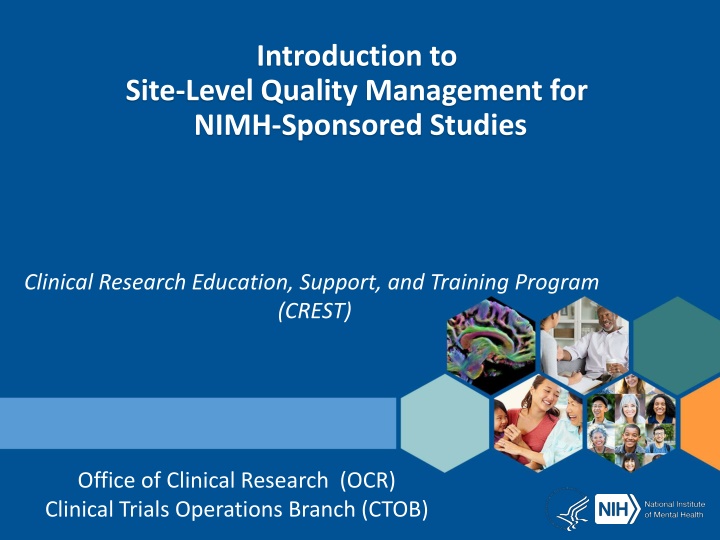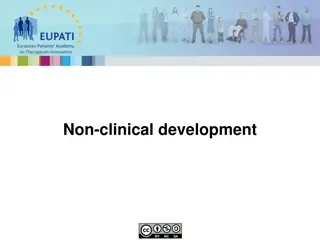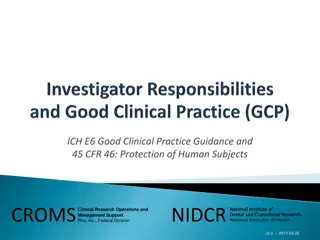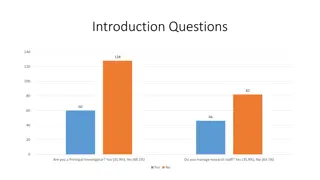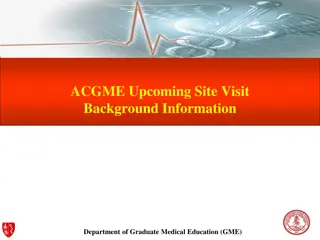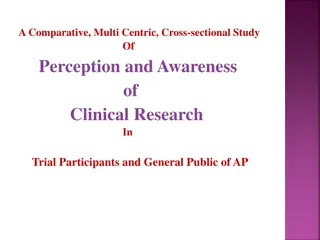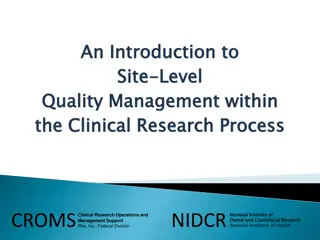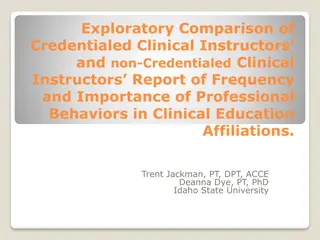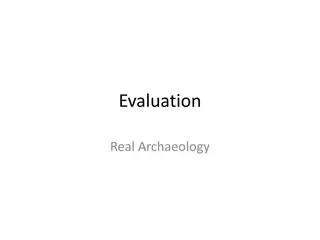Site-Level Quality Management in Clinical Research Education
This content introduces Site-Level Quality Management for NIMH-Sponsored Studies in the Clinical Research Education, Support, and Training Program. It covers the definition of quality management, tools available to support it, objectives, levels of involvement, and common sources of errors in clinical research. Emphasizing the importance of proactive error prevention, the content underscores the need for a comprehensive quality management strategy to ensure data integrity and proper study conduct.
Download Presentation

Please find below an Image/Link to download the presentation.
The content on the website is provided AS IS for your information and personal use only. It may not be sold, licensed, or shared on other websites without obtaining consent from the author.If you encounter any issues during the download, it is possible that the publisher has removed the file from their server.
You are allowed to download the files provided on this website for personal or commercial use, subject to the condition that they are used lawfully. All files are the property of their respective owners.
The content on the website is provided AS IS for your information and personal use only. It may not be sold, licensed, or shared on other websites without obtaining consent from the author.
E N D
Presentation Transcript
Introduction to Site-Level Quality Management for NIMH-Sponsored Studies Clinical Research Education, Support, and Training Program (CREST) Office of Clinical Research (OCR) Clinical Trials Operations Branch (CTOB)
Objectives and Overview To define and describe quality management (QM) as it relates to site-level documentation, processes, and activities To describe tools that are available to support site- level QM 3
Quality Management (QM) Definition and Levels of Involvement The sponsor/Investigator should implement a system to manage quality throughout all stages of the trial process (ICH-E6 GCP 5.0.) The overall process of establishing and ensuring the quality of processes, data, and documentation associated with clinical research activities QM occurs at multiple levels of the clinical research process: sponsor, external clinical monitoring, study, and individual site levels 4
Objectives of Quality Management When QM activities are implemented, a standard of data integrity and proper study conduct is established QM includes BOTH processes aimed at prevention of errors as well as those associated with detection and correction of errors Proactive prevention of errors means less time and resources are required to correct errors downstream 5
Objectives of Quality Management Continued Ensuring sufficient quality management activities exist and are being properly executed is even more important than the classification of those efforts Studies need an overall quality management strategy that includes written procedures, ongoing verification of documentation, and additional review of compliance with written procedures/guidelines/ regulations 6
Most Common Source of Errors at any Stage of Clinical Research Insufficient written procedures Written procedures not followed Training not done or incomplete Lack of ongoing checks to assess errors Individual roles and responsibilities are unclear or undefined Quality Management plans focus on these aspects of research to ensure quality 7
Components of Quality Management Quality Management includes two main components: Quality Control Quality Assurance Quality Management 8
Quality Assurance and Quality Control The sponsor is responsible for implementing and maintaining quality assurance and quality control systems with written Standard Operating Procedures (SOPs) to ensure that trials are conducted and data are generated, documented (recorded), and reported in compliance with the protocol, GCP, and the applicable regulatory requirement(s) (ICH-E6 GCP 5.1.) 9
Quality Assurance (QA) Definition Quality Assurance All those planned and systematic actions that are established to ensure that the trial is performed, and the data are generated, documented (recorded), and reported in compliance with GCP and the applicable regulatory requirement(s) This includesthe generation of procedural documents to guide quality activities and the review of documentation to assess adherence to written procedures, policies, and regulations 10
QA Examples Relevant site staff activities would include, but not be limited to: Creation of written Standard Operating Procedures (SOPs)/ Manual of Procedures (MoP) describing step-by-step activities associated with a particular aspect of protocol execution Review of completed or partially completed checklists of QC activities to confirm that an established quality process is being followed Review training logs to ensure that sufficient and relevant training has been appropriately completed and documented 11
Quality Control (QC) Definition Quality Control The operational techniques and activities undertaken within the quality assurance system to verify that the requirements for quality of the trial-related activities have been fulfilled It is the ongoing review of data collection forms and other records for completeness and logic 12
QC Examples Relevant site staff activities would include, but not be limited to: Completion of checklists to confirm the appropriateness of each subject s informed consent process Systematic comparison of the electronic (or paper, if applicable) clinical data to the medical records or other source documentation Ongoing review of the contents of the Essential Documents Binder (a.k.a. Investigator Site File/Binder, Regulatory Binder) for completeness Maintaining temperature logs on specimen storage freezers 13
SOP Development for QA/QC The development and use of SOPs are an integral part of a successful quality system as it provides individuals with the information to perform a job properly, and facilitates consistency in the quality and integrity of a product or end- result. The term SOP may not always be appropriate and terms such as protocols, instructions, worksheets, and laboratory operating procedures may also be used. EPA Guidance for Preparing Standard Operating Procedures section 1.1 The Manual of Procedures (MoP) Template available on the NIMH Toolbox for Clinical Researchers, lists suggested Data Quality Checks (some sites use the term SOP and MoP interchangeably) 14
Preparing a Clinical Quality Management Plan The Clinical Quality Management Plan (CQMP) establishes the quality management guidelines for tasks related to a specific clinical study at a particular clinical site The purpose of the CQMP is to identify the processes and activities that will be used to monitor and facilitate quality protocol execution This CQMP is a living document, reviewed on a regular schedule, and updated, as needed, to ensure continued or improved quality management 15
Subject Record Review The following key indicators, as applicable, should be reviewed on an ongoing basis by a qualified person other than the person entering the information: Informed Consent, Assent Process Eligibility Criteria Concomitant/Prohibited Medications Adverse Event (AE)/Serious Adverse Event (SAE) and Unanticipated Problem (UP) Reporting Investigational Product Administration Missed Visits/Tests and Follow-up Treatment/Study Discontinuation Other Study-specific Indicators (as determined by site staff) 16
Essential Documents Binder Quality Review The quality review of essential documents should include all documents listed in the International Conference on Harmonisation (ICH) Guidelines for Good Clinical Practice (GCP) E6, Section 8, Essential Documents for the Conduct of a Clinical Trial and any study-specific or sponsor-required document Quality reviews of regulatory files should be conducted at least annually 17
Storage of QM Materials All quality management checklists, plans, completed tools, and reports should be stored in a quality management binder, which is maintained separately from the essential documents binder 18
Resources ICH E6 Guidance https://database.ich.org/sites/default/files/E6_R2_Addendum.p df Office for Human Research Protections (OHRP) http://www.hhs.gov/ohrp/ NIMH Clinical Research Toolbox: https://www.nimh.nih.gov/funding/clinical-research/clinical- research-toolbox/nimh-clinical-research-toolbox.shtml 19
Contact NIMH Office of Clinical Research (OCR) Clinical Research Education, Support, and Training (CREST) Program Email: nimhctob_crest@mail.nih.gov 20
